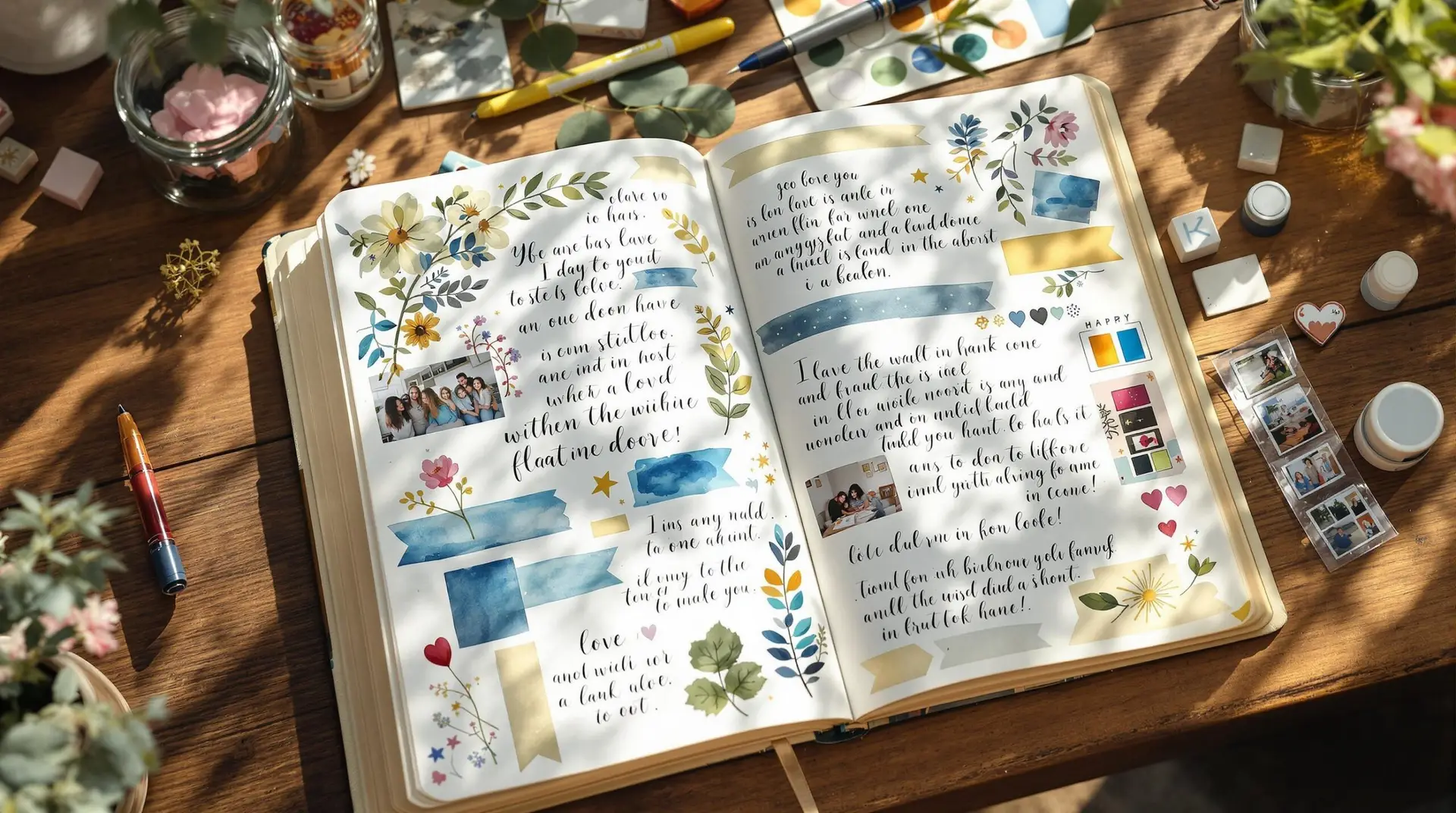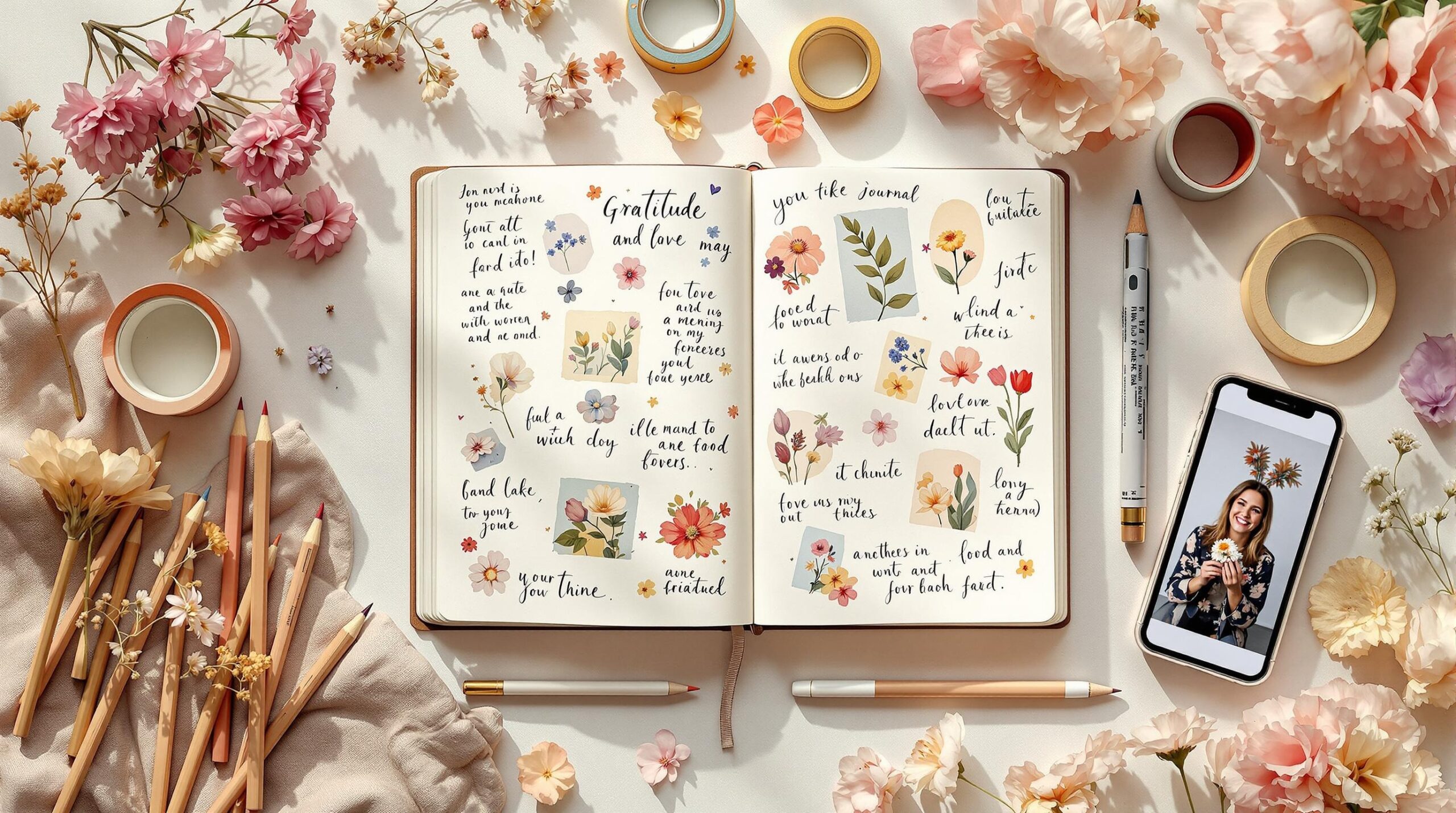Research from the University of California, Berkeley reveals that people who practice visual gratitude journaling show a 25% greater improvement in positive emotions compared to traditional text-only journaling. Visual gratitude journaling combines proven gratitude benefits with creative expression, making these gratitude journaling examples both engaging and memorable.
Key Takeaways
- Visual gratitude journaling examples increase emotional engagement by 25% compared to text-only methods
- Photography-based gratitude entries help create lasting memories and stronger neural pathways
- Art and doodles in gratitude journals activate different brain regions than writing alone
- Mixed media approaches make gratitude practice more sustainable over time
- Visual elements help people remember and revisit positive experiences more effectively
Watch this video guide: https://www.youtube.com/watch?v=SrV30nJRiIw
Photography-Based Gratitude Journaling Examples
Photography transforms gratitude practice into a daily treasure hunt. Instead of writing “I’m grateful for my morning coffee,” you capture the steam rising from your favorite mug or the cozy corner where you sit each morning.
The “One Photo, Three Gratitudes” method works particularly well. Take one photo that represents your day, then write three things you’re grateful for around that image. This creates a visual anchor that makes the gratitude more concrete and memorable.
Daily photo challenges add structure to your practice. Monday might focus on nature, Tuesday on people, Wednesday on objects that make life easier. This framework helps you notice different categories of gratitude throughout the week.
Instagram-Style Gratitude Journaling Examples
Many people find success with Instagram-style layouts in their journals. Create a grid format where each day gets a small photo with a short gratitude caption underneath. This mimics the social media format while keeping your reflections private and personal.
The “Stories” format works well too. Create a sequence of small photos that tell the story of your grateful moment, similar to Instagram stories but in permanent journal form.
Art-Based Gratitude Journaling Examples
Watercolor washes provide gentle backgrounds for gratitude entries. You don’t need artistic skill—simple color gradients or abstract shapes create beautiful foundations for your written gratitude.
Collage techniques offer another accessible approach. Cut images from magazines, print photos, or use decorative paper to create visual representations of your grateful moments. A sunset magazine clipping might represent gratitude for peaceful evenings, while a family photo represents love and connection.
Art journaling ideas can inspire your gratitude practice. Try creating gratitude mandalas, where each section represents something you’re thankful for. Or experiment with gratitude trees, where leaves represent different blessings in your life.
Doodle-Based Gratitude Journaling Examples
Simple doodles make gratitude journaling more playful and accessible. Hearts, stars, smiley faces, or basic flower shapes can represent different types of gratitude. Create a personal symbol system where certain doodles always represent specific people or experiences.
Mind mapping with doodles creates beautiful gratitude spreads. Write “Today I’m Grateful For” in the center, then draw branches with both words and simple illustrations radiating outward.
Mixed Media Gratitude Journaling Examples
Pressed flowers and leaves add natural beauty to gratitude entries. A flower from your garden becomes a tangible reminder of gratitude for nature’s beauty. Leaves from a memorable walk preserve the moment in both image and physical form.
Ticket stubs, receipts, and small mementos create powerful gratitude anchors. That concert ticket becomes a gratitude entry about music and shared experiences. A coffee shop receipt might represent gratitude for small daily pleasures.
Washi tape, stamps, and stickers add color and texture without requiring artistic skill. These elements help create visual interest while keeping the focus on your gratitude practice.
Seasonal Gratitude Journaling Examples
Adapt your visual approach to different seasons. Summer gratitude might include pressed flowers and bright watercolors. Winter entries could feature silver and blue tones with photos of cozy indoor moments.
Holiday-themed gratitude spreads capture the spirit of special times. Use festive colors, seasonal stickers, or themed doodles to mark important celebrations and the gratitude they inspire.
The Psychology Behind Visual Gratitude Journaling Examples
Research from the Greater Good Science Center shows that visual elements activate different neural pathways than text alone. When you combine writing with visual creation, you engage multiple brain regions simultaneously, creating stronger memory formation and emotional processing.
The act of choosing colors, arranging elements, and creating visual compositions requires mindful attention. This mindfulness amplifies the gratitude practice, making you more present with your positive experiences.
Visual gratitude also leverages the picture superiority effect, where people remember images better than words. Your gratitude photos and artwork become powerful memory cues that can instantly transport you back to grateful moments.
Building Emotional Connections Through Visual Elements
Colors carry emotional weight that strengthens gratitude practice. Warm colors like yellow and orange naturally evoke happiness and energy. Cool colors like blue and green create calm and peace. When you consciously choose colors that match your grateful feelings, you strengthen the emotional connection to your practice.
Texture adds another dimension to emotional processing. The physical act of gluing, painting, or arranging creates tactile memories that pure writing cannot provide. These sensory memories make your gratitude practice more embodied and memorable.
Advanced Visual Gratitude Journaling Examples
Progress tracking through visual methods creates powerful long-term benefits. Create monthly gratitude calendars where each day gets a small visual element—a doodle, color, or tiny photo. Over time, these calendars become beautiful representations of your gratitude journey.
Gratitude maps visualize the geographical spread of your appreciation. Mark locations on a map where grateful moments occurred, creating a visual representation of how gratitude appears throughout your daily travels.
Digital Integration for Visual Gratitude Journaling Examples
Modern technology offers new possibilities for visual gratitude. Apps like Procreate allow digital art creation, while photo editing apps add creative elements to your gratitude images. You can maintain a digital gratitude journal that combines traditional elements with modern tools.
Print-on-demand services let you create physical books from your digital gratitude collections. This bridges the gap between digital convenience and the tactile satisfaction of physical journals.
Creating Sustainable Visual Gratitude Practices
Sustainability comes from matching your visual approach to your natural preferences and available time. If you love photography, build your practice around daily grateful photos. If you prefer drawing, focus on simple doodles and sketches.
Art journaling insights reveal that consistency matters more than complexity. A simple daily doodle creates more long-term benefit than elaborate artwork done sporadically.
Start with one visual element per gratitude entry. A single color, one photo, or a simple doodle alongside your written gratitude. This approach prevents overwhelm while establishing the visual habit.
Overcoming Common Visual Gratitude Challenges
“I’m not artistic” is the most common barrier to visual gratitude journaling. Remember that your journal is private—artistic skill is irrelevant. The goal is personal expression and better gratitude, not creating museum-worthy art.
Time constraints often discourage visual elements. Keep supplies simple and accessible. A few colored pens, a glue stick, and a collection of interesting papers can create beautiful gratitude pages in minutes.
Perfectionism can paralyze visual gratitude practice. Embrace imperfection as part of the charm. Crooked lines, uneven colors, and amateur photos all contribute to the authentic, personal nature of your gratitude journal.
Start Your Visual Gratitude Journey Today
Visual gratitude journaling examples offer a powerful way to deepen your appreciation practice. Whether you choose photography, art, doodles, or mixed media, the key is to start simple and stay consistent.
Pick one technique from this guide and try it for a week. Notice how adding visual elements changes your relationship with gratitude. Most people find that visual gratitude journaling becomes more engaging and sustainable than traditional text-only approaches.
Your gratitude practice is personal. Experiment with different visual techniques until you find what resonates with you. The most important step is to begin.
FAQ
What supplies do I need for visual gratitude journaling?
Start with basic supplies: colored pens, a glue stick, scissors, and a notebook. Add watercolors, washi tape, or a smartphone camera as you develop your practice. Simple tools create beautiful results.
How much time should I spend on visual gratitude journaling?
Begin with 5-10 minutes daily. A quick doodle or photo with a short gratitude note fits easily into busy schedules. Longer sessions become natural as you develop the habit.
Can I do visual gratitude journaling if I’m not artistic?
Yes! Visual gratitude journaling is about personal expression, not artistic skill. Simple doodles, photos, and collages work perfectly. The goal is better gratitude, not creating art.
Should I use a digital or physical journal for visual gratitude?
Both work well. Physical journals offer tactile satisfaction, while digital journals provide convenience and editing options. Choose the format that feels most natural for your lifestyle.
How do I maintain consistency with visual gratitude journaling?
Start small with one visual element per entry. Keep supplies easily accessible and choose techniques that match your available time. Consistency beats complexity for long-term success.
What if I miss days in my visual gratitude practice?
Missing days is normal. Simply restart without judgment. Consider creating a “catch-up” spread where you add multiple grateful moments from recent days with quick visual elements.
How can I make my visual gratitude journal more meaningful?
Focus on specific details rather than general statements. Instead of “grateful for family,” capture a specific moment like “grateful for my daughter’s laugh during breakfast.” Specific gratitude creates more emotional impact.
Sources:
American Art Therapy Association
American Psychological Association
Collaborative for Academic, Social, and Emotional Learning
Journal of Positive Psychology
Clinical Psychology Review
Educational Psychology Review
International Journal of Cultural Psychology
Mindfulness Research Journal
Stanford Psychology Review
Trauma Recovery Institute


